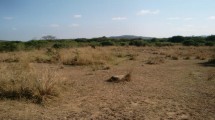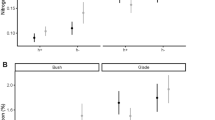Abstract
In African savannas, bottom-up soil nutritional factors and top-down herbivory have both been suggested to control the distribution patterns of bunch and lawn grasses. We tested the separate and combined roles of these factors on grassland distribution in a South African savanna by focusing on three main objectives, namely (1) are grazing patches and lawns restricted to specific soils or sites, (2) does herbivory alter rates of nutrient cycling which facilitates lawns and (3) are there any differences in foliage quality between lawn and bunch grass-dominated sites that might influence animals in choosing to feed on lawns? We set up ten sites along a grazing gradient in the Hluhluwe-iMfolozi Park in KwaZulu-Natal, South Africa. At these sites, we measured total soil nutrients, soil nutrient turnover rates and grass foliage nutrient concentrations. We found that in the Hluhluwe-iMfolozi Park the spatial distribution of lawn and bunch grassland types appears to be an animal-driven phenomenon and not dependent on specific soil properties. The short-structured and distinct species found in lawns do not appear to be restricted to nutrient-enriched patches. However, the grasses of these lawns had significantly higher nutrient concentrations, in their foliage, which might explain the high attraction to these patches by herbivores. We also did not find any animal-induced stimulation of nutrient cycling rates that are often associated with lawn grass species.





Similar content being viewed by others
References
Archibald S (2008) African grazing lawns—how fire, rainfall and grazer numbers interact to affect grass community states. J Wildl Manag 72:492–501. doi:10.2193/2007-045
Archibald S, Bond WJ, Stock WD, Fairbanks DHK (2005) Shaping the landscape: fire–grazer interactions in an African savanna. Ecol Appl 15:96–109. doi:10.1890/03-5210
Arsenault R, Owen-Smith N (2008) Resource partitioning by grass height among grazing ungulates does not follow body size relation. Oikos 117:1717–1771
Arshad MA (1982) Influence of the termite Macrotermes michaelseni (Sjöst) on soil fertility and vegetation in a semi-arid savannah ecosystem. Agro-Ecosystem 8:47–58. doi:10.1016/0304-3746(82)90014-2
Augustine DJ (2003) Long-term, livestock-mediated redistribution of nitrogen and phosphorus in an east African savanna. J Appl Ecol 40:137–149. doi:10.1046/j.1365-2664.2003.00778.x
Augustine DJ, McNaughton SJ (2004) Temporal asynchrony in soil nutrient dynamics and plant production in a semiarid ecosystem. Ecosystems (NY, Print) 7:829–840. doi:10.1007/s10021-004-0253-1
Bakker ES, Olff H, Boekhoff M, Gleichman JM, Berendse F (2004) Impact of herbivores on nitrogen cycling: contrasting effects of small and large species. Oecologia 138:91–101. doi:10.1007/s00442-003-1402-5
Balfour DA, Howison OE (2002) Spatial and temporal variation in a mesic savanna fire regime: responses to variation in annual rainfall. Afr J Range Forage Sci 19:45–53
Belsky AJ (1994) Influences of trees on savanna productivity: test of shade, nutrients and tree-grass competition. Ecology 75:922–932. doi:10.2307/1939416
Blair JM (1997) Fire, N availability, and plant response in grasslands: a test of the transient maxima hypothesis. Ecology 78:2359–2368
Botha S, Stock WD (2005) Stable isotope composition of faeces as an indicator of seasonal diet selection in wild herbivores in southern Africa. S Afr J Sci 101:371–374
Burke IC (1989) Control of N mineralization in a sagebrush steppe landscape. Ecology 70:1112–1126
Cech PG, Kuster T, Edwards PJ, Venterink HO (2008) Effects of herbivory, fire and N2-fixation on nutrient limitation in a humid African savanna. Ecosystems (NY, Print) 11:991–1004. doi:10.1007/s10021-008-9175-7
Cromsight JPGM, Olff H (2008) Dynamics of grazing lawn formation: an experimental test of the role of scale-dependent processes. Oikos 117:1444–1452. doi:10.1111/j.0030-1299.2008.16651.x
De Angelis DL (1989) Nutrient dynamics and food-web stability. Annu Rev Ecol Syst 20:71–95. doi:10.1146/annurev.es.20.110189.000443
Du Toit JT, Cumming DHM (1999) Functional significance of ungulate diversity in African savannas and the ecological implications of the spread of pastoralism. Biodiv Conserv 8:1643–1661
Firer N, Schimel JP (2002) Effects of drying-rewetting frequency on soil carbon and nitrogen transformations. Soil Biol Biochem 34:777–787. doi:10.1016/S0038-0717(02)00007-X
Frank DA, Groffman PM (1998) Ungulate vs landscape control of soil C and N processes in grasslands of Yellowstone National Park. Ecology 79:2229–2241
Frank DA, Groffman PM, Evans RD, Tracy BF (2000) Ungulate stimulation of nitrogen cycling and retention in Yellowstone Park grasslands. Oecologia 123:116–121. doi:10.1007/s004420050996
Gough L, Grace JB (1998) Herbivore effects on plant species density at varying productivity level. Ecology 79:1586–1594
Graham PM (1992) The response of grasses to fire and bush clearing in the Hluhluwe game reserve. Thesis. University of Natal, Durban, South Africa
Grant CC, Scholes MC (2006) The importance of nutrient hot-spots in the conservation and management of large wild mammalian herbivores in semi-arid savannas. Biol Conserv 130:426–437. doi:10.1016/j.biocon.2006.01.004
Hobbs NT (1996) Modification of ecosystems by ungulates. J Wildl Manag 60:695–713. doi:10.2307/3802368
Knops JMH, Bradley KL, Wedin DA (2002) Mechanisms of plant species impacts on ecosystem nitrogen cycling. Ecol Lett 5:454–466. doi:10.1046/j.1461-0248.2002.00332.x
Le Roux X, Bardy M, Loiseau P, Louault F (2003) Stimulation of soil nitrification and denitrification by grazing in grasslands: do changes in plant species composition matter? Oecologia 137:417–425. doi:10.1007/s00442-003-1367-4
McIvor J, McIntyre G, Saeli I, Hodgkinson JJ (2005) Patch dynamics in grazed sub-tropical native pastures in south-east Queensland. Aust Ecol 30:445–464. doi:10.1111/j.1442-9993.2005.01488.x
McNaughton SJ (1985) Ecology of a grazing ecosystem: the serengeti. Ecol Monogr 55:259–294. doi:10.2307/1942578
McNaughton SJ, Banyikwa FF, McNaughton MM (1997) Promotion of the cycling of diet-enhancing nutrients by African grazers. Science 278:1798–1800. doi:10.1126/science.278.5344.1798
Murphy J, Riley JP (1962) A modified single solution method for the determination of phosphate in natural waters. Anal Chim Acta 27:31–36. doi:10.1016/S0003-2670(00)88444-5
Novellie P (1990) Habitat use by indigenous grazing ungulates in relation to sward structure and veld condition. J Grass Soc S Afr 7:16–23
Owen-Smith N (1988) Megaherbivores, the influence of very large body size on ecology. Cambridge University Press, Cambridge
Owen-Smith N, Danckwerts JE (1997) Herbivory. In: Cowling RM, Richardson RM, Pierce SM (eds) Vegetation of southern Africa. Cambridge University Press, Cambridge, pp 397–420
Pastor J, Dewey B, Naiman RJ, McInnes RJ, Cohen Y (1993) Moose browsing and soil fertility in the boreal forests of Isle-Royale National Park. Ecology 74:467–480. doi:10.2307/1939308
Ritchie ME, Tilman D, Knops JMH (1998) Herbivore effects on plant and nitrogen dynamics in oak savanna. Ecology 79:165–177
Ruess RW, Seagle SW (1994) Landscape patterns in soil microbial processes in the Serengeti National Park, Tanzania. Ecology 75:892–904. doi:10.2307/1939414
Singer FJ, Schoenecker KA (2003) Do ungulates accelerate or decelerate nitrogen cycling? For Ecol Manag 181:189–204. doi:10.1016/S0378-1127(03)00133-6
Stohlgren TJ, Schell LD, Heuvel BV (1999) How grazing and soil quality affect native and exotic plant diversity in rocky mountain grasslands. Ecol Appl 9:45–64. doi:10.1890/1051-0761(1999)009[0045:HGASQA]2.0.CO;2
Van der Krift TAJ, Berendse F (2001) The effect of plant species on nitrogen mineralization. J Ecol 89:555–561. doi:10.1046/j.0022-0477.2001.00580.x
van de Vijver CADM, Poort P, Prins HHT (1999) Causes of increased nutrient concentration in post-fire regrowth in an east African savanna. Plant Soil 214:173–185. doi:10.1023/A:1004753406424
Verweij RJT, Verrelst J, Loth PE, Heitköonig MA, Brunsting MH (2006) Grazing lawns contribute to the subsistence of mesoherbivores on dystrophic savannas. Oikos 114:108–116. doi:10.1111/j.2006.0030-1299.14209.x
Vinton MA, Burke IC (1995) Interactions between individual plant species and soil nutrient status in shortgrass Steppe. Ecology 76:1116–1133. doi:10.2307/1940920
Waldram MS, Bond WJ, Stock WD (2008) Ecological engineering by a mega-grazer: white rhino impacts on a South African Savanna. Ecosystems (NY, Print) 11:1010–1112. doi:10.1007/s10021-007-9109-9
Wedin DA, Pastor J (1993) Nitrogen mineralization dynamics in grass monocultures. Oecologia 96:186–192. doi:10.1007/BF00317731
Wedin DA, Tilman D (1990) Species effects on nitrogen cycling: a test with perennial grasses. Oecologia 84:433–441
Young TR, Patridge N, Macrae A (1995) Long-term glades in acacia bushland and their edge effects in Laikipia, Kenya. Ecol Appl 5:97–108. doi:10.2307/1942055
Acknowledgements
This research was funded by the National Research Foundation of South Africa and the Andrew Mellon Foundation through the Zululand Grassland Project (ZLGP). We thank Dave Balfour and Sue van Rensburg and their research staff at the Hluhluwe-iMfolozi Park for their support and facilitation of the project. KZN Wildlife is acknowledged for allowing us to work in their reserve. We would also like to thank the staff of the ZLGP, Krissie Krook, Bernard Frauenknicht, Thobile Shelembe, Sinenhlanhla Mhlongo and their colleagues for assistance with sample collection. Thanks are also due to Tony Swemmer and Sally Archibald for their comments on the manuscript.
Author information
Authors and Affiliations
Corresponding author
Rights and permissions
About this article
Cite this article
Stock, W.D., Bond, W.J. & van de Vijver, C.A.D.M. Herbivore and nutrient control of lawn and bunch grass distributions in a southern African savanna. Plant Ecol 206, 15–27 (2010). https://doi.org/10.1007/s11258-009-9621-4
Received:
Accepted:
Published:
Issue Date:
DOI: https://doi.org/10.1007/s11258-009-9621-4




